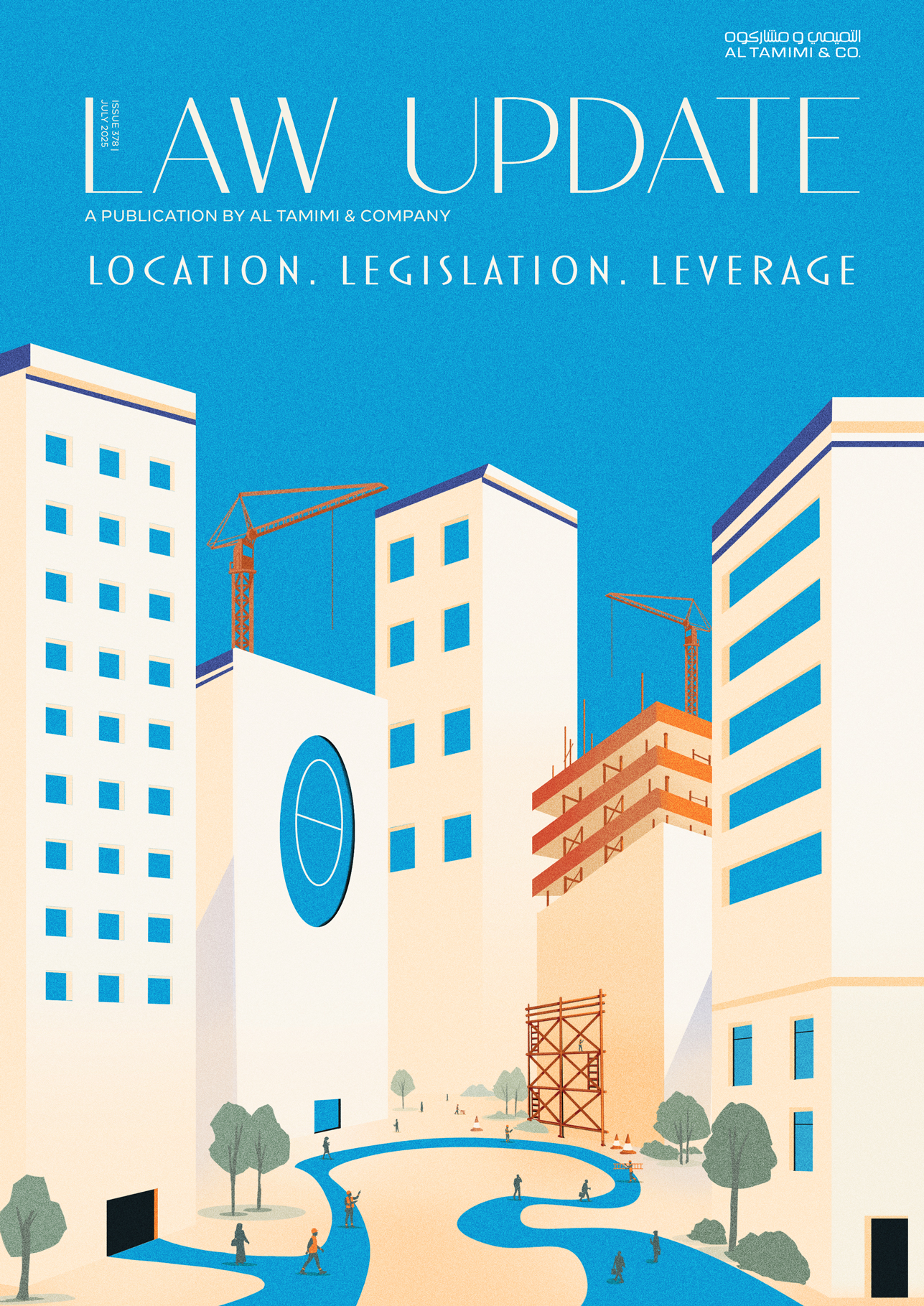- Arbitration
- Banking & Finance
- Capital Markets
- Commercial
- Competition
- Construction & Infrastructure
- Corporate / Mergers & Acquisitions
- Corporate Services
- Corporate Structuring
- Digital & Data
- Dispute Resolution
- Employment & Incentives
- Family Business & Private Wealth
- Innovation, Patents & Industrial Property (3IP)
- Insurance
Find a Lawyer
Book an appointment with us, or search the directory to find the right lawyer for you directly through the app.
Find out more
Real Estate & Construction and Hotels & Leisure
Real estate, construction, and hospitality are at the forefront of transformation across the Middle East – reshaping cities, driving investment, and demanding increasingly sophisticated legal frameworks.
In the June edition of Law Update, we take a closer look at the legal shifts influencing the sector – from Dubai’s new Real Estate Investment Funds Law and major reforms in Qatar, to Bahrain’s push toward digitalisation in property and timeshare regulation. We also explore practical issues around strata, zoning, joint ventures, and hotel management agreements that are critical to navigating today’s market.
As the landscape becomes more complex, understanding the legal dynamics behind these developments is key to making informed, strategic decisions.


2025 is set to be a game-changer for the MENA region, with legal and regulatory shifts from 2024 continuing to reshape its economic landscape. Saudi Arabia, the UAE, Egypt, Iraq, Qatar, and Bahrain are all implementing groundbreaking reforms in sustainable financing, investment laws, labor regulations, and dispute resolution. As the region positions itself for deeper global integration, businesses must adapt to a rapidly evolving legal environment.
Our Eyes on 2025 publication provides essential insights and practical guidance on the key legal updates shaping the year ahead—equipping you with the knowledge to stay ahead in this dynamic market.
The leading law firm in the Middle East & North Africa region.
A complete spectrum of legal services across jurisdictions in the Middle East & North Africa.
-
Practices
- All Practices
- Banking & Finance
- Capital Markets
- Commercial
- Competition
- Construction & Infrastructure
- Corporate / Mergers & Acquisitions
- Corporate Services
- Corporate Structuring
-
Sectors
-
Country Groups
-
Client Solutions
Today's news and tomorrow's trends from around the region.
17 offices across the Middle East & North Africa.
Our Services
 Back
Back
-
Practices
- All Practices
- Banking & Finance
- Capital Markets
- Commercial
- Competition
- Construction & Infrastructure
- Corporate / Mergers & Acquisitions
- Corporate Services
- Corporate Structuring
- Digital & Data
- Dispute Resolution
- Employment & Incentives
- Family Business & Private Wealth
- Innovation, Patents & Industrial Property (3IP)
- Insurance
- Intellectual Property
- Legislative Drafting
- Private Client Services
- Private Equity
- Private Notary
- Projects
- Real Estate
- Regulatory
- Tax
- Turnaround, Restructuring & Insolvency
- Compliance, Investigations and White-Collar Crime
-
Sectors
-
Country Groups
-
Client Solutions
- Law Firm
- /
- Insights
- /
- Law Update
- /
- January – February 2012
- /
- QFMA Promotes Listing Of SMEs
QFMA Promotes Listing Of SMEs
Kamal Hafez
The QFMA has circulated the Draft Regulations for consultation, and the Draft Regulations are expected to be endorsed and to come into force soon.
The Draft Regulations reflect the awareness of the QFMA of the important and vital role that Small and Medium Enterprises (the “SMEs”) play in the national economy. The QFMA realises that giving the opportunity to SMEs to list their shares in the capital market will provide such SMEs with funding mechanisms to help them expand, and reach out, to new markets, and correspondingly support the national economy.
The Draft Regulations include a package of benefits for SMEs to motivate such SMEs to list their stock in the Second Market (the market designated for trading of SMEs shares in the Qatar Exchange). The Draft Regulations provide for offering and listing requirements which are more flexible compared to those of the Main Market in relation to minimum capital requirements, shareholders, number of shares required to be offered for public subscription, financial history of the company, in addition to less disclosure requirements which do not prejudice the security and integrity of the capital market.
We highlight below the most important provisions set out in the Draft Regulations:
1. Capital
The Draft Regulations allow companies with capital not exceeding QR 40 million to offer and list their shares in the Second Market at Qatar Exchange. This will allow companies with capital as small as QR 10 million to be publicly traded in the stock market in Qatar, as the QFMA Regulations on Offering and Listing of securities issued in 2010 (the “QFMA Regulations”) does not allow companies to list their shares in the Qatar Exchange, unless they have a minimum capital of QR 40 million (the QFMA Regulations are only applicable to companies with capital exceeding QR 40 million).
2. Shareholders
Currently, the QFMA Regulations does not allow companies to list their shares in the Qatar Exchange, unless they have a minimum of 100 shareholders. The Draft Regulations contain a provision which allow companies having not less than 15 shareholders to list their shares in the Qatar Exchange. This provision will allow SMEs with limited number of shareholders/founders to be publically traded companies.
3. Shares
The Draft Regulations provide that at least 10% of the issuer’s capital must be offered for public subscription. However, the Draft Regulations are not clear if a company should offer 10% of its existing shares or issue new shares amounting to 10% of its capital. These issues are expected to be clarified upon endorsement of the Draft Regulations.
The Draft Regulations appears to be significantly more flexible in relation to the minimum number of shares that shall be offered for public subscription compared to the QFMA Regulations, as the latter provides that a company may not offer less than 40% or more than 80% of its shares for the public.
4. Financial History
Pursuant to the QFMA Regulations, an issuer must provide the QFMA with audited financial statements in relation to the company’s latest three financial years. The Draft Regulation includes a lesser restriction in this regard, as it requires the issuer to submit audited financial statements for the company’s latest financial year.
5. Disclosure Requirements
The Draft Regulations provide for a diluted ongoing reporting requirement compared to listed companies regulated by the QFMA Regulations. The Draft Regulations provide that a listed company must file with the QFMA annual and semi-annual reports, while under the QFMA Regulations a listed company must file with the QFMA quarterly, semi-annual and annual reports.
Additionally, the QFMA Regulations provide that a listed company must file disclosures to the QFMA and QE, in addition to posting such disclosure reports on the issuer’s website. Additionally, the annual report must be published in two daily newspapers, one of which in Arabic. The Draft Regulations do not require publication in newspapers, as it only requires filing the disclosure reports with the QFMA and QE, in addition to posting the same on the company’s website.
Conclusion
The Draft Regulations are expected to facilitate the listing of shares of SMEs in the Qatar Exchange through flexible procedures which commensurate with the structures of SMEs, while maintaining a strong level of supervision and control to ensure transparency and protection of interests of SMEs’ shareholders. We have seen a common feature in markets of the region, when leading shares fall they pull down the whole market and possibly surrounding markets given that the majority of the exchanges host mostly leading shares. With this proposed new dynamic, by adding SME’s, the severity of cross market implications can be cautioned in our view and will allow positive movement on the equity markets in Qatar and possibly the region when the Draft Regulations is promulgated.
Stay updated
To learn more about our services and get the latest legal insights from across the Middle East and North Africa region, click on the link below.


